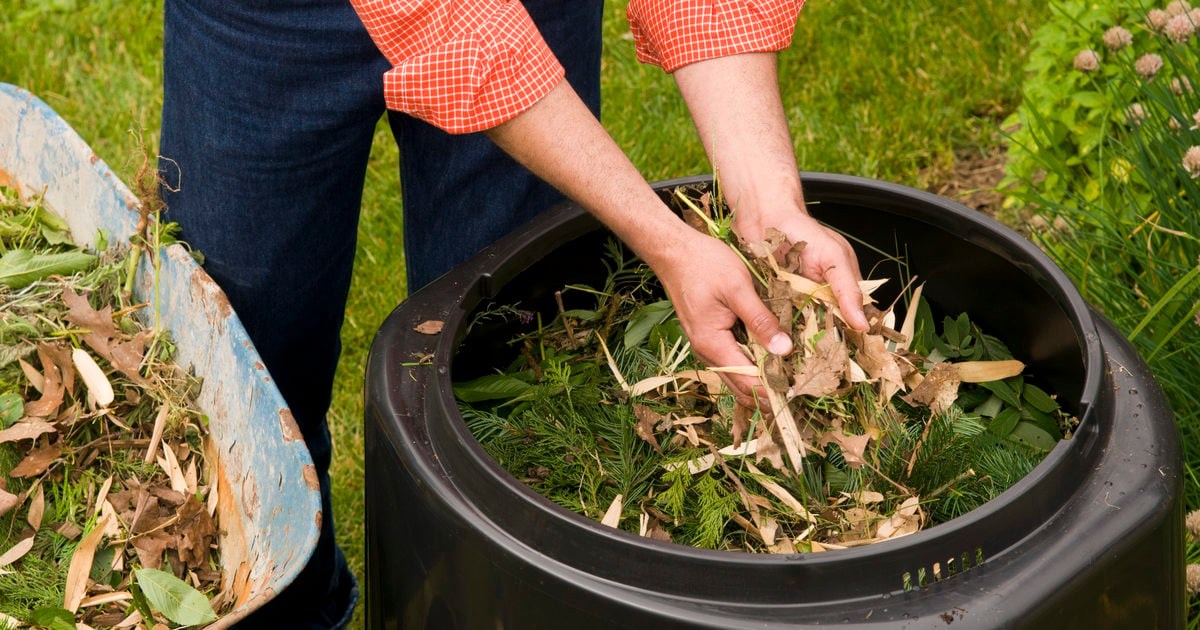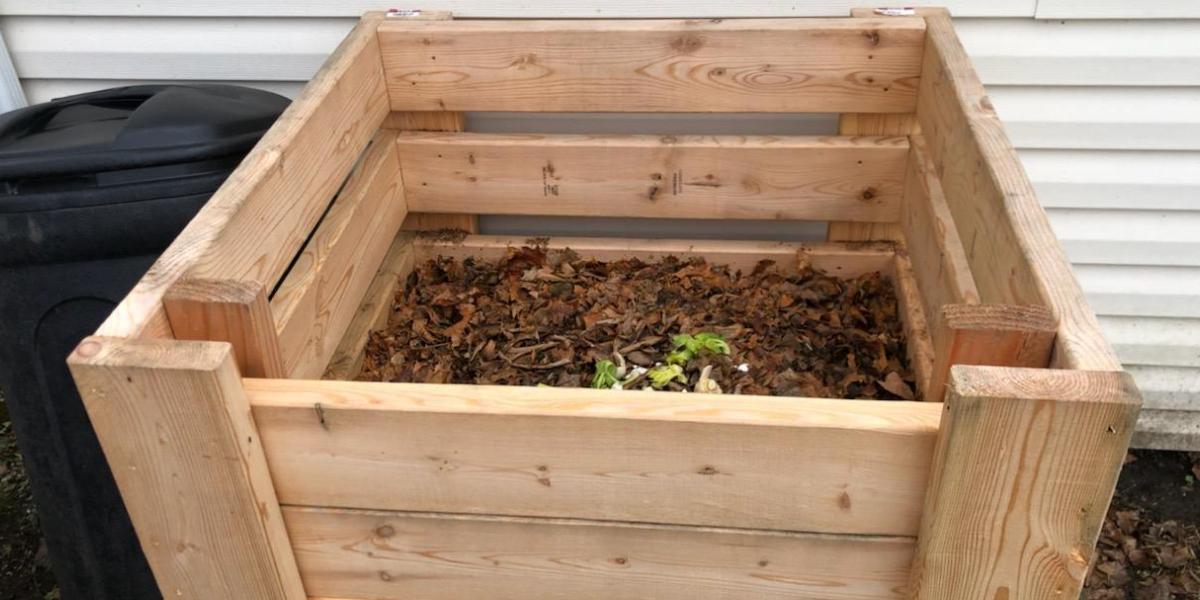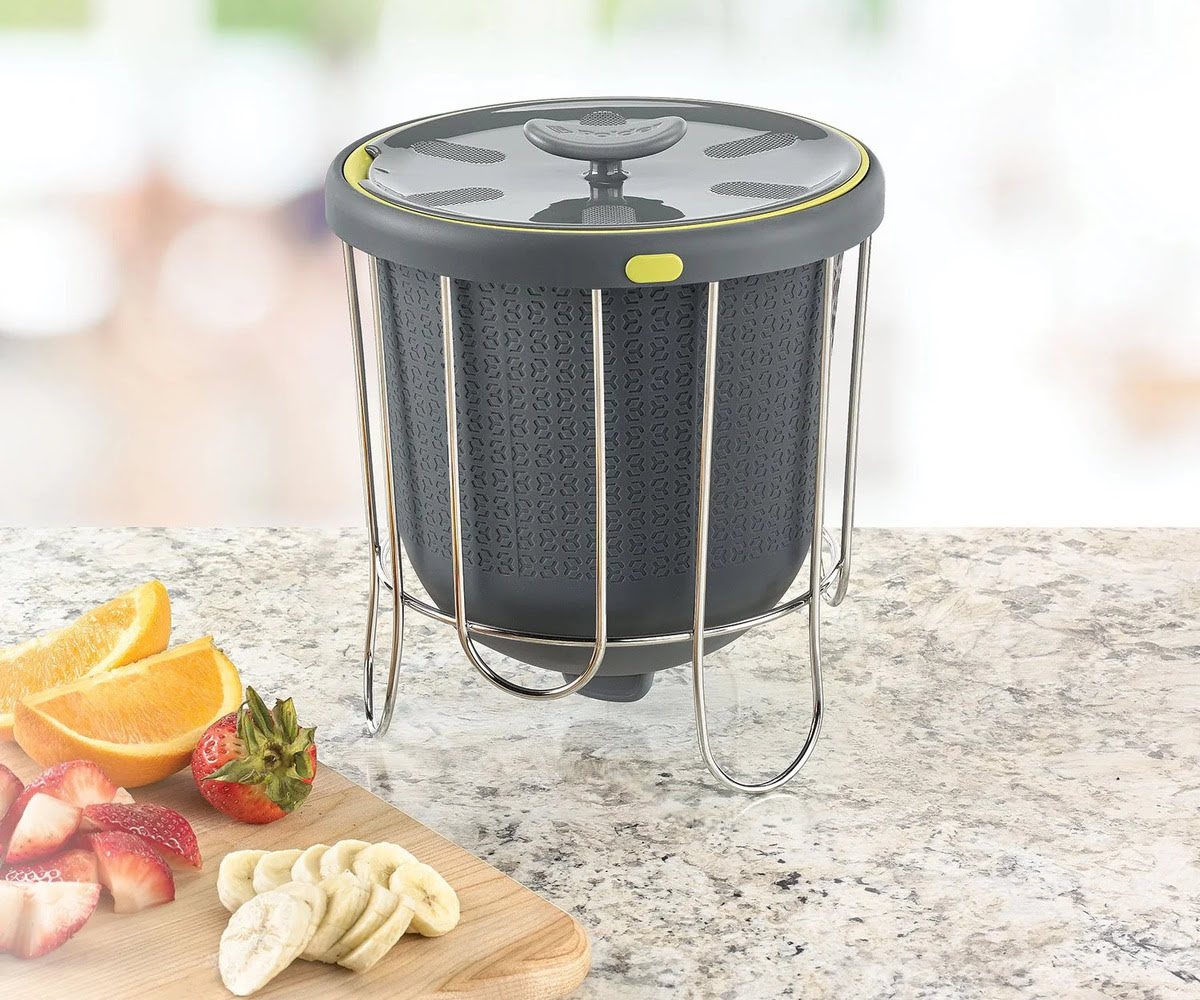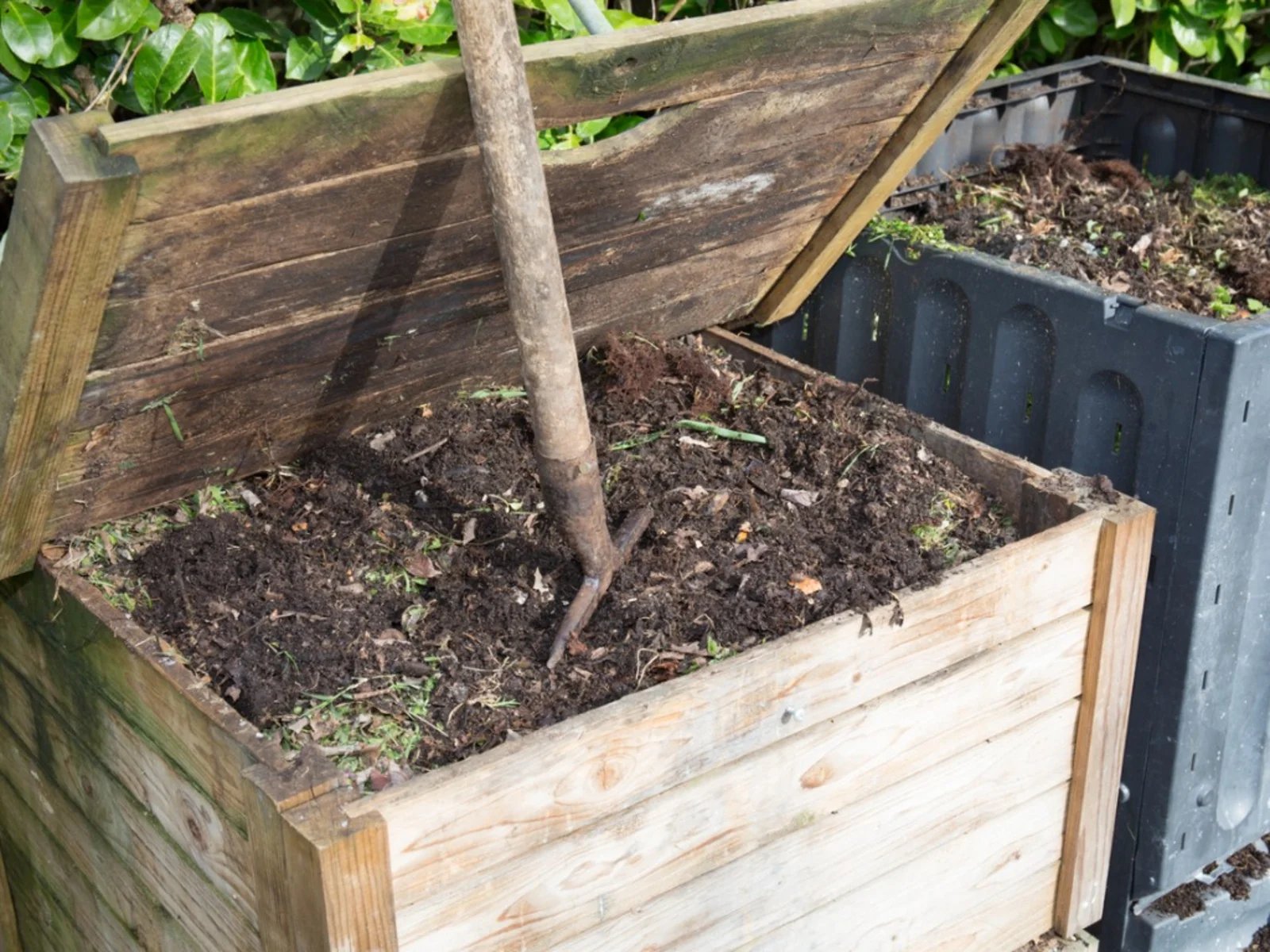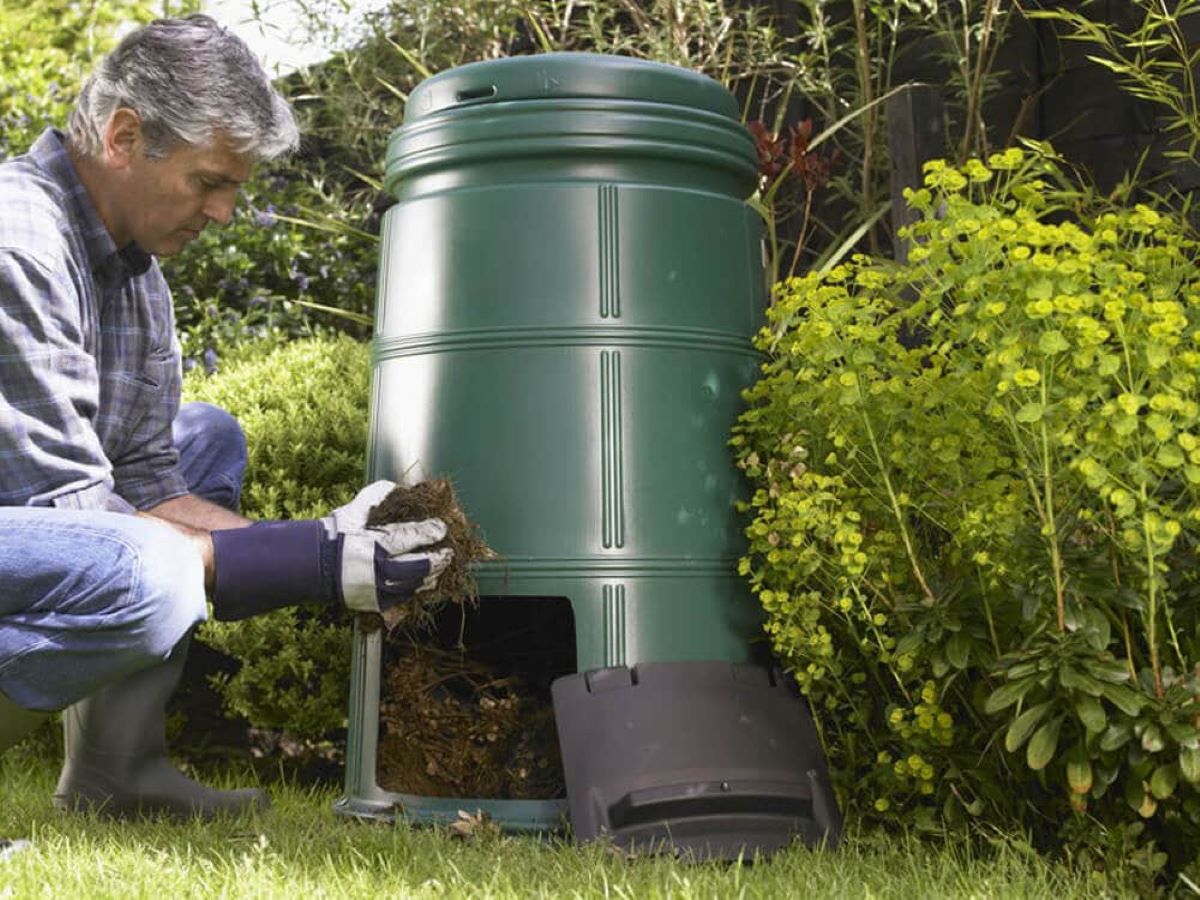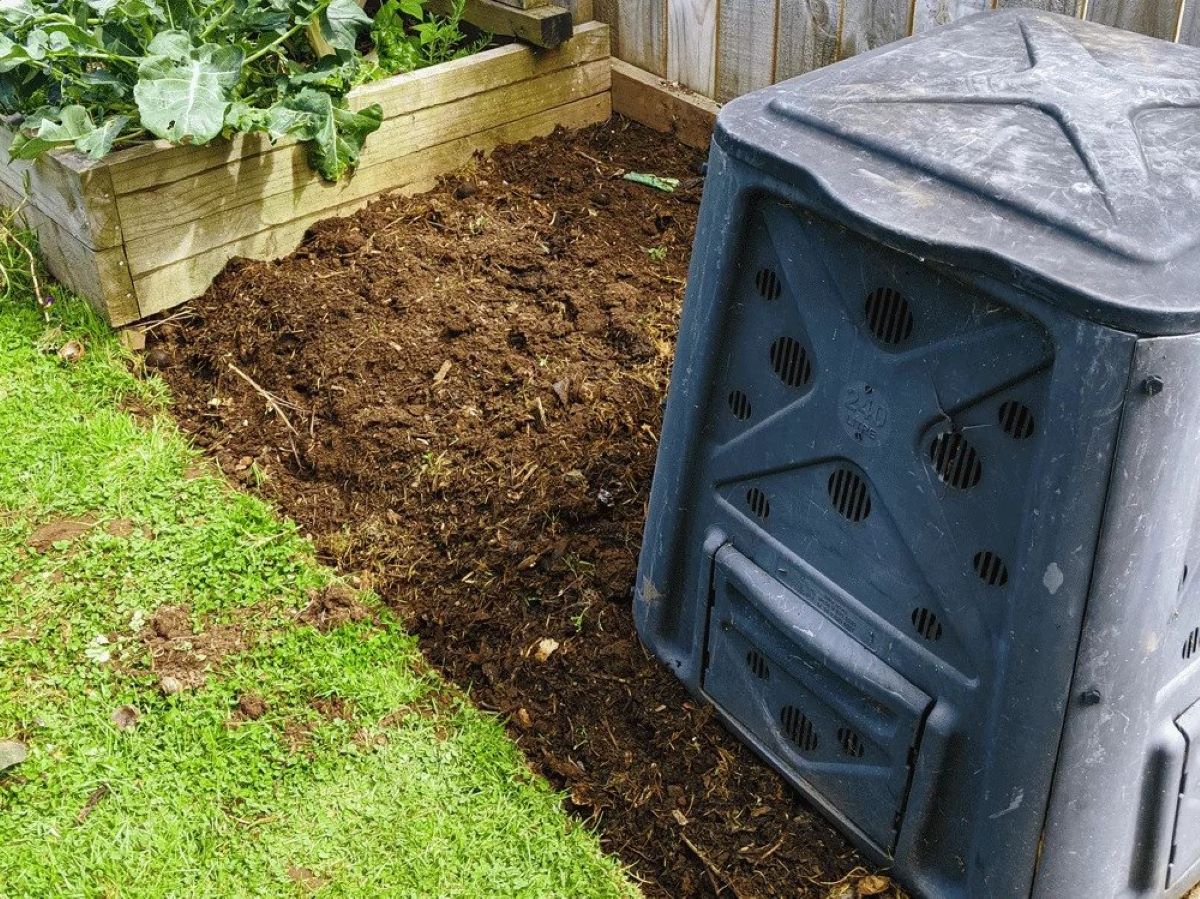Home>Gardening Basics>Tools and Equipment>How To Use Countertop Compost Bin
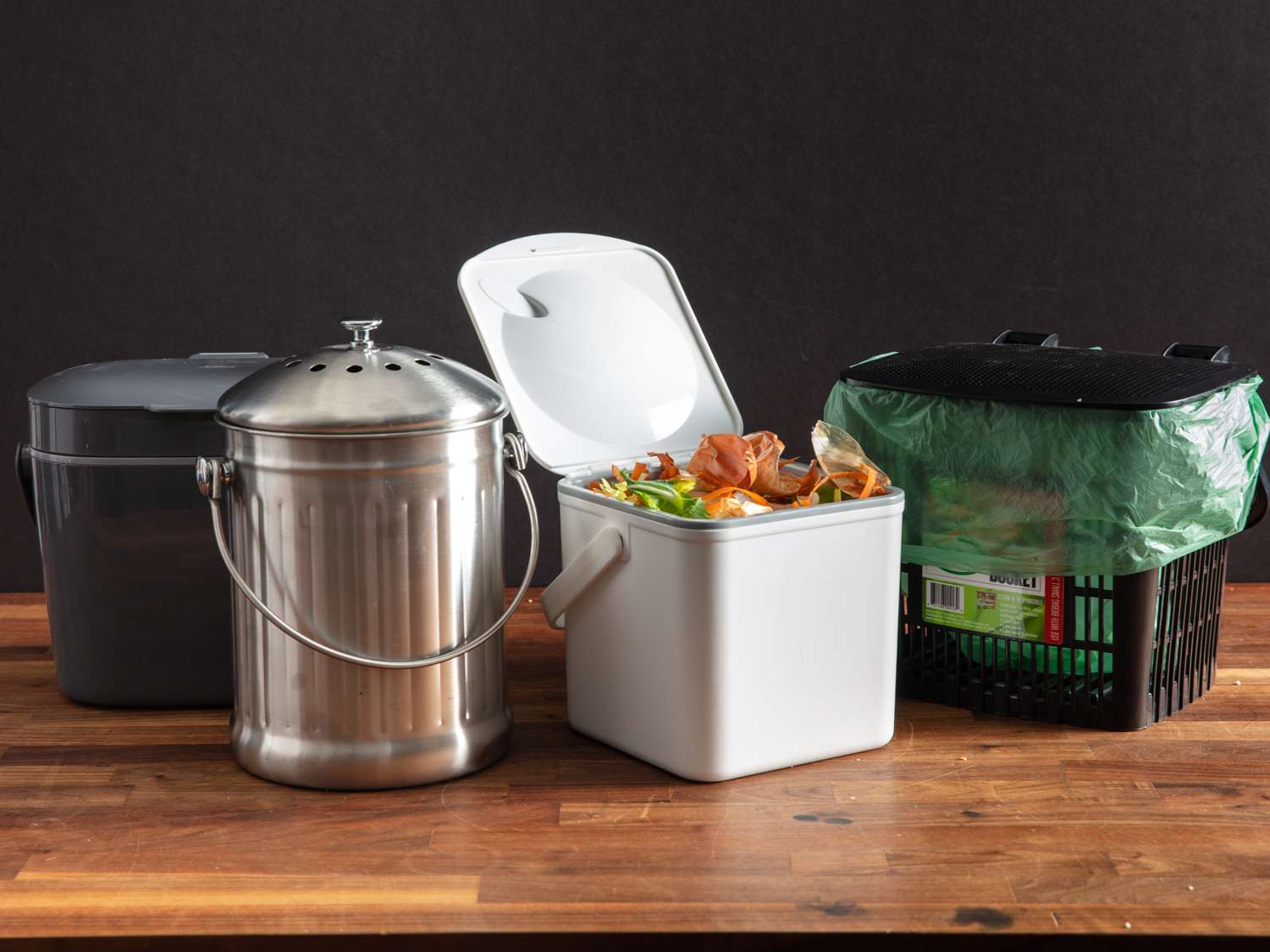

Tools and Equipment
How To Use Countertop Compost Bin
Modified: January 22, 2024
Learn how to effectively utilize a countertop compost bin as part of your eco-friendly kitchen routine. Find the best tools and equipment for seamless composting.
(Many of the links in this article redirect to a specific reviewed product. Your purchase of these products through affiliate links helps to generate commission for Chicagolandgardening.com, at no extra cost. Learn more)
Table of Contents
- Introduction
- Benefits of Using a Countertop Compost Bin
- Choosing the Right Countertop Compost Bin
- Setting Up Your Countertop Compost Bin
- What to Compost in Your Countertop Compost Bin
- Managing Odor in Your Countertop Compost Bin
- Maintaining and Emptying Your Countertop Compost Bin
- Tips for Successful Composting with a Countertop Compost Bin
- Conclusion
Introduction
Countertop compost bins have become increasingly popular in recent years as more people are looking for sustainable ways to reduce their waste and contribute to a greener environment. These compact and convenient bins allow you to compost food scraps and other organic materials right in your kitchen, eliminating the need to throw them in the trash.
Composting is the process of breaking down organic matter into nutrient-rich soil, which can then be used for gardening and landscaping. Traditionally, composting has been done outdoors in large bins or piles. However, countertop compost bins provide a smaller scale option for those who want to compost on a smaller scale or don’t have access to outdoor space.
Using a countertop compost bin is not only beneficial for the environment, but it also has several advantages for the user. By composting your food scraps, you can reduce the amount of waste that goes to the landfill, where it contributes to greenhouse gas emissions. Additionally, composting allows you to create natural, nutrient-rich soil that can improve the health and fertility of your garden or potted plants.
In this article, we will explore the benefits of using a countertop compost bin, discuss how to choose the right bin for your needs, provide tips on setting up and maintaining your bin, and offer guidance on what can and cannot be composted in a countertop bin. Whether you are an avid gardener or simply want to make a positive impact on the environment, using a countertop compost bin is a simple and effective way to reduce waste and support sustainable living.
Benefits of Using a Countertop Compost Bin
Using a countertop compost bin offers numerous benefits for both individuals and the environment. Let’s explore some of the key advantages:
- Reduced Waste: By using a countertop compost bin, you can divert kitchen scraps from ending up in the landfill. Food waste accounts for a significant portion of municipal waste, and landfilling it contributes to harmful greenhouse gas emissions. Composting your organic waste helps reduce the overall waste footprint and minimizes your impact on the environment.
- Nutrient-Rich Soil: Composting transforms food scraps and organic materials into nutrient-rich soil known as humus. Humus is a valuable resource for enriching soil and promoting healthy plant growth. By incorporating compost into your garden or potted plants, you can improve the soil structure, increase water retention, and provide essential nutrients for thriving plants.
- Cost Savings: Composting at home eliminates the need to purchase expensive commercial fertilizers or soil amendments. Instead, you can create your own high-quality compost for free using kitchen scraps and other biodegradable materials. This not only saves money in the long run but also reduces dependence on chemical-based fertilizers, making it a more sustainable choice.
- Convenience and Accessibility: Countertop compost bins provide a convenient way to compost right in your kitchen. This eliminates the need to make frequent trips to an outdoor compost pile or bin, especially during inclement weather. Having a compost bin within reach encourages regular composting, making it a seamless part of your daily routine.
- Reduced Odor and Pests: One common concern with composting is the potential for unpleasant odors and attracting pests. Countertop compost bins are typically designed with features like airtight lids and carbon filters to minimize odors and prevent pests from accessing your compost. These features help create a more pleasant composting experience and ensure a clean and odor-free kitchen.
- Teachable Moment: Composting is not only beneficial for adults but also provides an excellent educational opportunity for children. By involving them in the composting process, you can teach them the importance of sustainable practices, the natural cycle of decomposition, and the value of reducing waste.
Overall, using a countertop compost bin is a practical and eco-friendly way to reduce waste, create nutrient-rich soil, and promote sustainable living. It offers several benefits, including reduced waste, cost savings, convenient access, reduced odor and pests, and educational opportunities. In the next sections, we will delve into how to choose the right countertop compost bin and provide tips on setting up and maintaining your bin for optimal composting results.
Choosing the Right Countertop Compost Bin
When it comes to selecting a countertop compost bin, there are a few key factors to consider. The right bin will suit your needs, fit well in your kitchen, and make the composting process smooth and efficient. Here are some tips to help you choose the right countertop compost bin:
- Size and Capacity: Consider the amount of compostable waste you generate on a regular basis. If you have a small household or produce minimal food scraps, a compact countertop compost bin might be sufficient. However, if you cook frequently or have a larger family, opting for a larger bin with a higher capacity will prevent the need for frequent emptying.
- Design and Aesthetics: Since the compost bin will sit on your countertop, it’s important to choose a design that complements your kitchen decor. Look for bins that have a sleek and compact design or come in different colors to match your style. Aesthetics should not be a major deciding factor, but it’s always nice to have a bin that blends seamlessly into your kitchen space.
- Odor Control: To prevent unpleasant odors in your kitchen, consider a countertop compost bin with effective odor control features. Look for bins that have airtight seals and carbon filters. The airtight seal will help contain odors, while the carbon filter will absorb and neutralize any potential smells. This will ensure that your kitchen remains fresh and odor-free.
- Easy to Clean: Compost bins can get messy, so choose a bin that is easy to clean. Look for bins made of durable and easy-to-wash materials such as stainless steel or plastic. Some bins have removable inner buckets, which can be easily taken out and rinsed. Having a bin that is easy to clean will make the composting process more hygienic and hassle-free.
- Convenience Features: Consider additional features that can enhance convenience. Look for bins with carry handles or lightweight construction for easy transportation. Bins with a lid that stays open for hands-free access are also convenient when you’re busy cooking. Some bins even have built-in storage for compostable bags or a slot for a carbon filter replacement. These added features can make composting a breeze.
- Budget: Determine your budget before shopping for a countertop compost bin. Prices can vary depending on size, materials, and additional features. Set a budget that you are comfortable with and look for bins within that range. Remember that investing in a high-quality compost bin will ensure a durable and long-lasting product.
By considering factors such as size and capacity, design and aesthetics, odor control, ease of cleaning, convenience features, and budget, you can find the perfect countertop compost bin that suits your needs and fits seamlessly into your kitchen. The next section will guide you through setting up and maintaining your compost bin for successful composting.
Setting Up Your Countertop Compost Bin
Setting up your countertop compost bin properly is essential for effective composting and odor control. Follow these steps to ensure a successful setup:
- Choose a Convenient Spot: Select a location on your countertop that is easily accessible and within reach of your food prep area. Consider placing the bin close to your sink for easy disposal of food scraps and convenient access to water for rinsing.
- Line the Bin: To make cleaning easier and prevent any residue from sticking to the bin, consider lining it with compostable bags or newspaper. This will help keep your bin clean and minimize odors. Make sure to use certified compostable bags that will break down along with the organic waste.
- Add a Carbon Layer: To help with moisture absorption and odor control, start by adding a layer of carbon-rich materials at the bottom of your compost bin. This can include shredded newspaper, dried leaves, or small pieces of cardboard. Aim to fill the bottom of the bin with around an inch of carbon material.
- Add Food Scraps and Green Material: As you go about your daily cooking routine, add your food scraps to the compost bin. This can include fruit and vegetable peels, coffee grounds, eggshells, and tea bags. Remember to balance out the high-nitrogen food scraps with carbon-rich “green” materials, such as grass clippings or fresh leaves, to maintain the right moisture and carbon-to-nitrogen ratio in your compost.
- Moisten as Needed: Check the moisture level of your compost bin regularly. It should be moist but not overly wet. If it feels dry, sprinkle some water into the bin to maintain the right moisture balance for decomposition. Avoid adding too much water, as this can lead to a smelly and anaerobic environment.
- Stir and Aerify: Using a small garden trowel or composting tool, stir the contents of your compost bin periodically to promote aeration. This helps to prevent compaction and allows oxygen to reach the microorganisms responsible for decomposition. Aeration is crucial for the composting process and helps prevent unpleasant odors.
- Empty Regularly: Once your countertop compost bin is full, it’s time to transfer the contents to a larger outdoor compost bin or pile. Empty the compost bin regularly to avoid any potential odor or pest issues. The frequency of emptying will depend on the size of your bin, the amount of waste you generate, and the temperature and humidity of your environment.
By following these steps and maintaining a good balance of food scraps and carbon materials, you can set up your countertop compost bin for successful composting. In the next section, we will explore what can and cannot be composted in a countertop bin to ensure that you are composting the right materials.
What to Compost in Your Countertop Compost Bin
Composting in your countertop bin is a great way to reduce waste and create nutrient-rich soil. However, it’s important to know what types of materials can and cannot be composted to ensure a successful composting process. Here are some guidelines on what you can compost in your countertop compost bin:
- Fruit and Vegetable Scraps: Most fruit and vegetable scraps are excellent additions to your compost bin. This includes peels, cores, seeds, stems, and rinds. However, be sure to avoid composting any moldy or spoiled fruits and vegetables, as they can introduce harmful pathogens and pests to your compost pile.
- Coffee Grounds and Filters: Coffee grounds are rich in nitrogen, which is beneficial for composting. Both coffee grounds and filters can be added to your compost bin. Just be mindful of any additives, such as sugar or creamer, which should be avoided.
- Eggshells: Eggshells are a good source of calcium and can be composted. Crush them before adding to your compost bin to speed up the decomposition process. Avoid adding egg yolks or egg whites, as they can attract pests.
- Tea Bags and Tea Leaves: Used tea bags and loose tea leaves can be composted. However, make sure to remove any staples or strings attached to tea bags before adding them to your compost bin.
- Plant Trimmings and Yard Waste: Pruned leaves, small branches, and grass clippings can all be composted in your countertop bin. Just be mindful to cut larger plant materials into smaller pieces to aid in faster decomposition.
- Paper and Cardboard: Shredded paper, newspaper, and cardboard can be composted as long as they are free from any glossy or colored print. These materials provide carbon and help maintain a balanced carbon-to-nitrogen ratio in your compost bin.
- Unbleached Paper Towels and Napkins: Used paper towels and napkins that are free from any chemicals can be composted. However, avoid composting those that have come into contact with meat or oily substances, as they may attract pests.
- Plant-Based Food Scraps: Leftover grains, pasta, bread, and other plant-based food scraps can be composted. Avoid adding any dairy, meat, or oily food products, as they can lead to odors and attract pests.
While the list of compostable materials for your countertop bin is extensive, there are certain items that should not be added. Avoid composting meat, fish, dairy products, oily foods, pet waste, and any materials treated with chemicals or pesticides. These materials can create unpleasant odors, attract pests, and may not break down properly in a small countertop bin.
By following these guidelines and composting the right materials, you can ensure that your countertop compost bin produces nutrient-rich compost for your garden or plants. In the next section, we will discuss how to manage odor in your countertop compost bin to create a pleasant composting experience.
Managing Odor in Your Countertop Compost Bin
One common concern with composting is the potential for unpleasant odors in your kitchen. However, by following a few simple steps, you can effectively manage odor in your countertop compost bin and maintain a fresh environment:
- Airtight Lid: Ensure that your countertop compost bin has an airtight lid. This will help seal in odors and prevent them from permeating your kitchen. Look for bins with snug-fitting lids that create a tight seal.
- Carbon Filters: Many countertop compost bins come with replaceable carbon filters. These filters help absorb and neutralize odors. Be sure to replace the filters regularly as recommended by the manufacturer to ensure their effectiveness.
- Layering: To minimize odors, layer your compost bin with carbon-rich materials, such as shredded newspaper or dried leaves, between layers of food scraps. This helps create an ideal balance of carbon and nitrogen and reduces the risk of unpleasant smells.
- Empty Regularly: Empty your countertop compost bin regularly to prevent the build-up of odorous materials. The frequency of emptying will depend on the size of your bin and the amount of waste you generate. Consider transferring the contents to a larger outdoor compost bin or pile to minimize the potential for odors.
- Avoid Liquids: Minimize the presence of liquids in your compost bin, as they can contribute to foul odors. If you have particularly wet food scraps, consider draining excess liquids before adding them to the bin.
- Keep it Dry: Maintaining a balanced moisture level is crucial. Excess moisture can lead to anaerobic conditions, which produce strong odors. If your compost bin becomes too wet, add dry carbon-rich materials like shredded newspaper or sawdust to absorb the excess moisture.
- Avoid Meat and Oily Foods: Meat, fish, and oily food scraps tend to produce strong odors. It is best to avoid adding these items to your countertop compost bin to prevent unpleasant smells and attract pests.
- Clean the Bin: Regularly clean your countertop compost bin to prevent any buildup of residue and odors. Wash it with hot, soapy water and rinse thoroughly. Consider using a natural deodorizer like vinegar or lemon juice to eliminate any lingering odors.
- Store in a Cool Place: If possible, store your countertop compost bin in a cool area of your kitchen. Heat can accelerate the decomposition process and potentially lead to stronger odors. Keeping the bin in a cool spot helps to maintain a more pleasant smelling composting environment.
By implementing these odor management techniques, you can ensure that your countertop compost bin remains fresh and odor-free. Composting can be an enjoyable and rewarding experience when odor is minimized, making it more inviting to continue your sustainable practices. In the next section, we will discuss how to properly maintain and empty your countertop compost bin.
Maintaining and Emptying Your Countertop Compost Bin
Maintaining and emptying your countertop compost bin is essential for successful composting and ensuring a clean and efficient composting process. Follow these tips to properly maintain and empty your bin:
- Monitor Moisture Levels: Check the moisture level of your compost bin regularly. It should be moist but not overly wet. If you notice excessive moisture, add dry carbon-rich materials like shredded newspaper or dried leaves to absorb the excess moisture and prevent unpleasant odors.
- Stir and Aerate: Periodically stir the contents of your compost bin with a small garden trowel or composting tool. This promotes aeration and helps prevent compaction. Aeration is crucial for proper decomposition and helps to control odors.
- Balance Carbon and Nitrogen: Maintain a balance between carbon-rich “brown” materials and nitrogen-rich “green” materials in your compost bin. Brown materials include items like shredded paper, dried leaves, and twigs, while green materials consist of kitchen scraps and fresh plant material. This balance will facilitate the breakdown of organic matter and ensure a healthy compost pile.
- Empty Regularly: When your countertop compost bin becomes full or starts to emit unpleasant odors, it’s time to empty it. The frequency of emptying will depend on factors such as the size of your bin, the amount of waste you generate, and environmental conditions. Consider transferring the contents to a larger outdoor compost bin or pile for further decomposition.
- Transfer to Outdoor Compost: When emptying your countertop compost bin, transfer the contents to an outdoor compost bin or pile. Layer the contents with other compostable materials, such as leaves, grass clippings, and yard waste. This will help create a well-balanced compost pile and facilitate thorough decomposition.
- Use Compost Properly: Once your compost has fully decomposed into rich, dark soil, it is ready to use in your garden or for potted plants. Incorporate it into the soil, or use it as a top dressing for added nutrients. Remember not to add fresh compost directly to the base of plants, as it can burn the roots. Allow compost to mature for a few weeks before applying it to your plants.
- Clean the Bin: After emptying your countertop compost bin, give it a thorough cleaning. Wash it with hot, soapy water, and rinse it well. Allow the bin to dry completely before lining it and starting the composting process again.
- Rotate Liners: If you use compostable bin liners, consider rotating them when emptying your compost bin. This ensures that any excess moisture or residue from the previous liner is not trapped in the bin, contributing to odors or attracting pests.
By properly maintaining and emptying your countertop compost bin, you can ensure a clean and efficient composting process. Regular monitoring of moisture levels, stirring and aerating the contents, and ensuring a balanced mix of carbon and nitrogen materials will contribute to the success of your compost. Additionally, transferring the compost to an outdoor compost bin and utilizing the mature compost in your garden will help close the sustainability loop. In the next section, we will provide additional tips for successful composting with a countertop compost bin.
Tips for Successful Composting with a Countertop Compost Bin
To make the most of your countertop compost bin and ensure successful composting, consider incorporating these tips into your composting routine:
- Cut Scraps into Smaller Pieces: Before adding food scraps to your compost bin, chop or cut them into smaller pieces. This helps accelerate the decomposition process and ensures that the scraps break down faster.
- Mix in Bulking Agents: Bulking agents such as shredded newspaper, dried leaves, or wood chips help create airflow within the compost pile. They also prevent the compost from getting too compacted, aiding in decomposition. Mix a handful of bulking agents into your countertop compost bin as needed.
- Alternate Layers: Layering your compost bin with a mix of green (nitrogen-rich) and brown (carbon-rich) materials helps create the ideal carbon-to-nitrogen ratio for decomposition. Alternate layers of food scraps with layers of carbon-rich materials like shredded paper or dried leaves to achieve a well-balanced compost mix.
- Avoid Overloading: It’s important not to overload your countertop compost bin with too much food waste at once. Adding excessive quantities of food scraps can lead to odor problems and slow down the decomposition process. Aim to add small amounts of waste consistently rather than a large amount all at once.
- Keep Bin Moist: Maintaining the right moisture level is crucial for efficient composting. Your compost should feel like a damp sponge. If it’s too dry, sprinkle water into the bin. If it’s too wet, add more carbon-rich materials like shredded paper to absorb excess moisture.
- Avoid Pests: To deter pests from your countertop compost bin, bury food scraps under a layer of carbon-rich materials. This will help mask the smell and discourage pests from being attracted to your compost. Additionally, emptying your bin regularly and keeping it clean will minimize the risk of pest infestation.
- Use Compostable Bags: If you prefer to use compostable bags in your countertop compost bin, ensure they are certified compostable and made from plant-based materials. These bags can help contain the compost and make it easier to transfer the contents to an outdoor compost bin or pile.
- Consider Vermicomposting: Another option for countertop composting is vermicomposting, which involves using worms to break down organic waste. Vermicomposting can be done in a specialized worm bin, and the worms speed up the decomposition process while producing nutrient-rich castings (worm poop) that make excellent compost for your plants.
- Educate Yourself: Continuously educate yourself about composting techniques, best practices, and troubleshooting common issues. There are numerous resources available, such as books, websites, and online communities, that can help improve your composting knowledge and skills.
By implementing these tips, you can enhance the efficiency and effectiveness of your countertop compost bin. Remember to be patient with the composting process, as it may take time for organic materials to break down fully. With consistency and proper care, you can transform your kitchen scraps into nutrient-rich compost to nourish your garden or plants.
Conclusion
Countertop compost bins offer a convenient and sustainable solution for reducing waste and creating nutrient-rich compost. By following the tips and guidelines discussed in this article, you can successfully compost food scraps and other organic materials right in your kitchen.
The benefits of using a countertop compost bin are numerous. Not only does it help reduce waste and minimize greenhouse gas emissions, but it also provides you with nutrient-rich soil that can improve the health of your plants and gardens. Composting at home also helps save money on fertilizers and promotes a more sustainable lifestyle.
When choosing a countertop compost bin, consider factors such as size, design, odor control, and ease of cleaning. These features will ensure that your composting experience is convenient and pleasant.
Proper setup and maintenance of your countertop compost bin are crucial for successful composting. Remember to balance green and brown materials, monitor moisture levels, and regularly stir and aerate the contents. Emptying the bin in a timely manner and transferring the compost to an outdoor compost pile or bin is important for continued composting success.
Additionally, managing odor, composting the right materials, and following best practices like cutting scraps into smaller pieces and layering your compost bin will contribute to effective and efficient composting.
Composting with a countertop compost bin is a sustainable practice that benefits both the environment and your own household. By diverting organic waste from landfills and harnessing its potential to create nutrient-rich compost, you are actively contributing to a greener future.
So why wait? Start composting with a countertop compost bin today and make a positive impact on the environment while enjoying the benefits of nutrient-rich soil for your plants.


